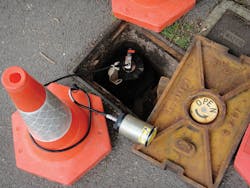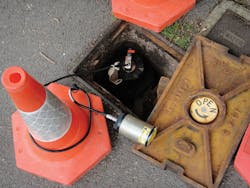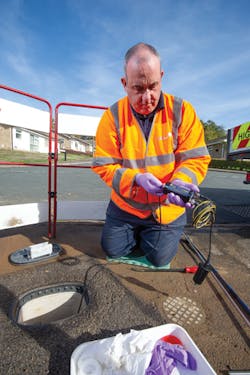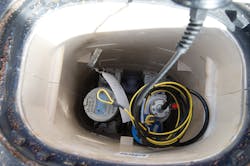Revolutionizing Remote Leak Identification
Acoustic sensor helps utilities and municipalities locate leaks in large-diameter, plastic pipes
By Dale Hartley
Leaks are a serious concern for water utilities across the world. It is not just a case of water not reaching the end user — leaks are expensive. They force utilities to fill the gaps in supply by drawing on freshwater supplies, thereby impacting aquatic habitats, reducing efficiency in water networks, contributing to future water system failures and allowing contaminants to enter the water supply.
A 2018 study titled Water Main Break Rates in the U.S. and Canada by Professor Steven Folkman of Utah State University found that 16 percent of installed water mains are beyond their useful life and utilities do not have the funds to replace them. Folkman reported that his basic survey gathered data from 201 utilities and that an average of 10 percent of water put into the system was lost due to leakage. In some cases, the scale of water lost through water mains leakage is reaching critical levels of 20 to 30 percent.
Market intelligence from The Northeast Group shows that in non-western countries the problem is even more serious. In the Indian city of Delhi, for example, water loss from leaks has reached 53 percent. India’s official non-revenue water rate is 34 percent, and other emerging nations are seeing losses up to 38 percent.
Market Forecast
The Northeast Group forecasts a massive increase in deployment of water management technology in order to deal with this problem, to somewhere in the order of US$46.5 billion of investment by 2023. This includes technology such as smart water meters, precision agriculture and irrigation systems, and advanced software analytics solutions.
This technology could in turn generate operational cost reductions of 3–5 percent while also increasing the accuracy of billing and enhancing leak detection.
Primayer’s Enigma3hyQ is a multi-point noise correlation system.
anglian roll-out
Leaks in long-distance and plastic pipelines are a particular problem in terms of detection and Anglian Water, a utility in eastern England, has responded by deploying immersed acoustic sensors to detect leaks.
The Enigma3hyQ sensor was developed in partnership with UK technology company Primayer to address hard-to-find leaks, particularly from large diameter and plastic pipes. In the UK, average leakage stands at 20 percent and water companies in England and Wales are being asked to cut losses by a minimum of 15 percent in the period from 2020 to 2025 and halve them by 2050.
Following successful trials, Anglian Water is undertaking installation of some 3,500 Enigma3hyQ leak detectors across its network by June 2019. The sensor comprises a multi-point noise correlation system which has been developed from, and is a variant of, the Enigma3m; both devices use cellular communications.
The hydrophone sensors are placed permanently within a pipe, deployed below ground. They locate leaks by capturing their acoustic signature, which is particularly groundbreaking for leak detection over longer distances and on large-diameter and plastic pipes.
The Enigma3hyQ delivers a distinct advantage over conventional accelerometer sensors, which have a reduced ability to detect noise from leaks in cases of limited sound propagation. These intelligent sensors transmit daily leak noise data to the Primayer server.
Time synchronization data is then correlated in order to accurately identify the presence and location of leaks, helping to confirm that the correlation results are accurate and due to leak noise.
Following successful trials, Anglian Water is undertaking installation of some 3,500 Enigma3hyQ leak detectors across its network by June 2019.
Precise Location
The location of each sensor can be displayed on Google Maps and these locations can be coded to show leak alarms. Historical data is also available and, together with the visualization of leak locations on Google Maps and Street View, assists leakage teams with management of leaks.
The following day, the sensors transfer the GPS location information and sound files to the PrimeWeb interface where the device operator can create a network diagram. The operator can also change the linear pipeline from a geographic information system (GIS) if the distances from the default Google Maps application are incorrect.
Confirmation of the probability that the noise correlation has been successful is provided to the operator in the form of a confidence factor.
Andy Smith, leakage optimization manager at Anglian Water, said, “One of the biggest challenges faced across the water industry is the ability to detect leaks effectively on plastic pipes as they don’t transmit noise when they leak. Critically, unlike more widely used methods, this new technology can be used on plastic pipes, which make up 60 percent of our water mains.
“This is a real game-changer in how we tackle leakage in terms of our teams on the ground and the processes we use. It will revolutionize what we do in terms of leakage,” Smith added.
“Working with our in-house data team we’ve also developed a dedicated modeling system which works out the optimum points across the water mains network to place the sensors,” he noted. “This precise deployment means the noise loggers can be installed much more efficiently.”
The hydrophone sensors are placed permanently within a pipe, deployed below ground. They locate leaks by capturing their acoustic signature, which is particularly groundbreaking for leak detection over longer distances and on large-diameter and plastic pipes.
Correlation Analysis
One feature of the Enigma3 technology — Multiday — will aggregate the sound files to form a much longer sound file for correlation analysis. The approximate location of the leak is shown on Google Street View to assist planning for the repair activity.
Primayer is one of ten companies jointly awarded the £40 million (US$53 million) framework agreement with Anglian Water for leak detection products, the aim being to ensure that the utility has as wide as possible a selection of equipment.
Barbara Hathaway, technical services director at Primayer, said, “Results from the trials of the Enigma3hyQ hydrophone sensor for leak detection with Anglian Water show fantastic promise. We anticipate a rapid uptake of this revolutionary technology worldwide.” WW
About the Author: Dale Hartley is a consultant at Primayer with over 20 years of experience with international projects. His areas of specialization include live pipeline condition assessment, acoustic technology, flow and pressure monitoring, and advanced pressure management. Primayer is based in Hampshire, UK, and has been manufacturing intelligent technologies for the global water network monitoring, leakage control and flow measurement market for over 20 years. Learn more at www.primayer.com.
Circle No. 248 on Reader Service Card



